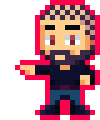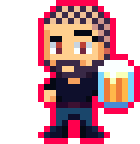The Little Things in Games
Developing games is a huge - and some would rightly say insane - undertaking. Even small games can end up being a surprising amount of work, and the end result tends to not reflect the actual project scope during development. The fact that games get finished at all is something of a miracle, to be honest. There are just so many things to consider, so many elements that have to be worked on, so many thingamabobs that have to be kajiggered in order to get a game working right. Just getting the basics done is tough and time-consuming.
Which makes it all the more incredible when devs find (or make) the time to add little things in their games. You know, little touches that are technically not needed but that enrich the game or its world, or simply put a smile on players' faces. The little things can turn a good game into a great one, or at least I like to think so.
The first “little thing” I remember coming across in my gaming journey is the idle animation of the original Sonic the Hedgehog. Don’t touch the controller for a while and Sonic will get impatient, tapping his foot and giving you the stink eye. It does not add anything to the gameplay and wouldn’t have warranted a delay of the game’s release date, but it just helps so much in making Sonic feel more like a real character instead of just a 2D sprite on a screen. Plus, it conveyed his attitude and as we all know, Sonic was all about that 90s ‘tude.

The second little thing I remember can be found in Castle of Illusion, the second game I got along with my Mega Drive and Sonic. While the game is full of charming graphics and little details, one thing stood out to me and my dad for some reason: When Mickey hits a ceiling, the game plays a little “thwock” sound. I’m not sure why, but this amused us greatly. It makes the world more real by emphasizing the weight and force behind the physical interaction, but it’s also just damn funny to see Mickey hit his head. Nobody would have missed it had the developers not put the sound in, but its presence does make the game a little bit better. This detail left such an impression on me that I implemented a bonking animation and sound effect into Go! Go! PogoGirl.

In fact, I try to add little flourishes like that in all of my games. Ever played [Speer] on Christmas? Maybe give it a try!
The little things certainly helped retro games to feel more real and interesting, but one could argue that they are even more important nowadays. With the increase in technology and graphical fidelity, game worlds can look frighteningly real. However, this also pushes them into the uncanny valley. A nature scene with photorealistic leaves and meticulously rendered grass swaying in the wind can still seem..off. Have you ever looked at those early access survival games on Steam? They tend to have realistic graphics as they use default or bought assets from Unreal 4 and other engines, but the worlds they create seem empty, hollow, a bit like a ghost town. A lot of times this is due to the lack of small details. If we’re in nature we see birds in the sky, insects buzzing about, clouds floating overhead. We hear the rustle of leaves, the chirping of birds, maybe an angry farmer in the distance. Without these details your scene will seem lifeless, strange and boring, no matter what resolution the leaf textures are.
But you don’t even need realistic graphics. The Legend of Zelda: The Wind Waker creates an amazing world with a very cartoony art style. And once again this is helped by the little things: Crabs on beaches will run away from you and burrow into the ground. Link will slip on ice if you try to turn around too fast. Pigs will start swimming back to the shore when you throw them into the water. And if they get angry because you hit them—which is a cool detail by itself—luring them into water will cool them off. It’s amazing how many little things the developers managed to cram into such a big game.

I guess my point is that the little things in games can make them truly special. They show that the developers put love into the game, and that love resonates with the player. Of course I’m not implying that a lack of details reflects a lack of love and care; sometimes the harsh reality of game development simply does not allow for details that management deems to be superfluous. When there’s a deadline, or when there’s not enough budget, your hands are pretty much tied. But if you have the time and opportunity to add little things and flourishes to your game, do it. I certainly will!
What are some of your favorite little things in games? Which made you smile, which stuck with you?

Want To Buy Me a Coffee?
Coffee rules, and it keeps me going! I'll take beer too, though.

Related Posts
Strange Hitboxes Can Make Your Game Better
Let’s play a little game. Which of these following statements have you caught yourself saying when dying in an action game? A Oh come on! That bullet was nowhere near me! This sucks! B Oh come on! My attack phased right through him! This sucks! C Oh come on! That bullet should have killed me! This sucks! I’m willing to bet that you’ve never said C. And the reason for that is obvious: We play games to have fun, and losing isn’t fun.
Sonic Mania Plus' Genius Tutorial
The long-awaited Sonic Mania Plus recently came out and I can easily remember the last time I had as much fun with a game—it was with the original Sonic Mania. Since I’ve beaten that game more than once I jumped straight into Encore mode on this one, anxious to try out the two new characters that were added in the update: Mighty the Armadillo and Ray the Squirrel. The gamer in me relished the entire trip through Angel Island zone, a sort of prologue stage of Encore Mode.
Comments
By using the Disqus service you confirm that you have read and agreed to the privacy policy.
comments powered by Disqus
